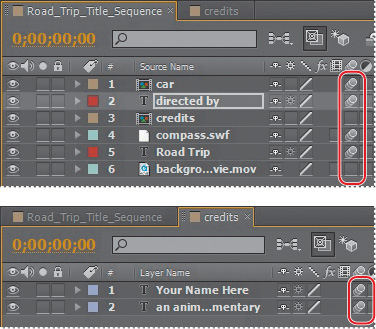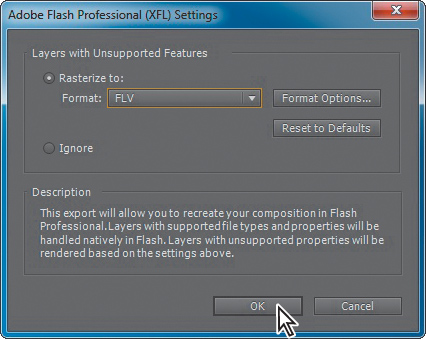Adding motion blur
Motion blur is the blur that occurs as an object
moves. You’ll apply motion blur to finesse the composition and make the
movement look more natural.
1. | In the Timeline panel, click the Motion Blur switch ( ) to enable motion blur for all of the layers except the background_movie and credits layers. ) to enable motion blur for all of the layers except the background_movie and credits layers.

|
Now, apply motion blur to the layers in the credits composition.
2. | Switch to the Credits Timeline panel, and enable motion blur for both layers.
|
3. | Switch
back to the Road_Trip_Title_Sequence Timeline panel, and select the
Motion Blur switch for the credits layer. Then click the Enable Motion
Blur button ( ) at the top of the Timeline panel so that you can see the motion blur in the Composition panel. ) at the top of the Timeline panel so that you can see the motion blur in the Composition panel.
|
4. | View a RAM preview of the entire, completed animation.
|
5. | Choose File > Save. |
Exporting to Adobe Flash Professional CS5
Note
If
After Effects can’t export an element of a composition as unrendered
data, it either ignores the element or renders it into a PNG or FLV
item, depending on whether you choose to ignore unsupported features.
If you’re preparing a project for a web page, you may want to continue working with it in Adobe Flash®
Professional CS5. You can export an After Effects composition as an XFL
file for use in Flash. The XFL format retains the composition’s layers
and keyframe data for its Transform properties (Position, Opacity,
Scale, and Rotation).
You’ll export your project to XFL format so that you
can work with it in Flash to integrate it with other animations or
continue to polish it for the web.
1. | Select the Road_Trip_Title_Sequence composition in the Project panel.
|
2. | Choose File > Export > Adobe Flash Professional (XFL).
|
3. | In
the Adobe Flash Professional (XFL) Settings dialog box, select
Rasterize To, and then select FLV from the Format pop-up menu. Then
click OK.

|
With this setting, After Effects will render elements that it can’t export natively as FLV components.
4. | In the Export As Adobe Flash Professional (XFL) dialog box, click Save.
|
After Effects exports the project. This process may
take a while, depending on the size of the project. After Effects
displays a progress bar as it exports the composition.
5. | If
you have Adobe Flash Professional CS5 installed, start it. Choose File
> Open, and open the XFL file you just exported from After Effects.
|